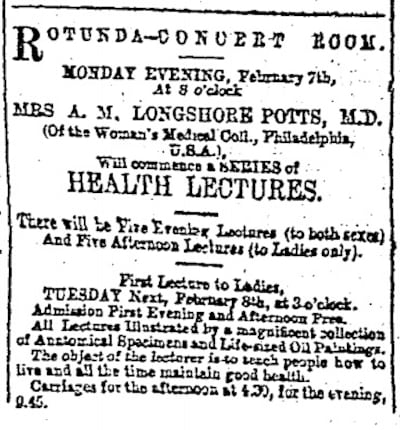Before the advent of cinema, or even radio, attending public lectures was a popular entertainment across Ireland. Audiences could choose from discourses about history, music, art, travel, religion, and, of course, medical matters.

Newspaper notices and accounts of these lectures shed some insight into social conditions and the state of the nation’s health in the later 19th century. Talks aimed at preventing smallpox, cholera, consumption, typhoid and other diseases dominated – such as “Disinfectants and their Uses” – but audiences also had interests similar to their modern counterparts, “Physical Education in Schools”, “Health of Children”, exercise, nutrition, working conditions, and even tenants’ sanitation rights.
Two renowned speakers on public health both served as professors of hygiene at the Royal College of Surgeons, Dr ED Mapother and Dr Charles Cameron.
Mapother regularly delivered a course of 12 free lectures on the “Hygienic subjects – Air, Ventilation, Water, Food, Baths, Clothing, Mental and Physical Exercise, Sanitary Engineering and Architecture, Soil, Climate, Preventable Diseases, Vital Statistics and Sanitary Organisation”. Audiences at his lecture on water learned about “its impurities; diseases produced by them and methods for their removal”, while Food covered: “Methods of preserving and preparing; diseases due to scanty and improper food; and adulteration”.
Mapother railed against pollution from chemical and gas works, factories, and slaughterhouses, and argued that improved drainage and sanitary measures had eradicated “ague” and further improvements could eradicate cholera.
Cameron continued the tradition of free lectures. In 1872, “The Skin and its Treatment” discussed the importance of “thorough and gentle but frequent ablutions, in keeping the pores open and in stimulating the nutrition of the skin”. Various soaps were exhibited and their qualities explained. “Brown Windsor, at 1s per pound, was often made from horse grease, and it contained minute particles of bone, which irritated the skin and caused pimples and worse symptoms . . .”
Also in 1872, Dr William O’Leary presented a course of lectures to the “working classes”.
‘Sweaters’
In one, he discussed the “sweaters” of Dublin’s tailoring trade. “In his experience as an hospital physician he had attended large numbers of the victims of this system, which he stigmatised as blood-letting, demoralizing, and death-dealing . . . Not far from Capel Street he knew of “a sweating house, or rather room, 11 feet broad, 3 feet long, and 7 feet height . . . According to the provisions of the Factory Act each person should have 3,000 cubic feet of air. In this place, the entire number of 14 had 1,800 feet . . .”
Dr O’Leary linked “sweaters” conditions to recent cases of smallpox in “mansions of the opulent”. He described how “situated not 2,000 yards from Dame Street – two children lay suffering from a very bad type of smallpox. Not only were the sweaters at work in the same apartment, but the clothes they were sewing . . . were used as a covering for the little sufferers. In another case he knew of, “a sewing machine having been worked by a female actually in smallpox, with the pustules upon her hands. It was no wonder, under these circumstances, that smallpox should have ‘jumped’ from the lower to the upper classes.”
Dirty air and ventilation were common themes. Cameron described: “the large quantity of organic matter which was present in the air of overcrowded rooms, railway carriages, &c, and showed that various kinds of diseases were induced by breathing air containing this excessive amount of organic matter”. He also advocated “the admission of light into our dwellings, and especially into sleeping apartments, because under the influence of light the air oxydised the dangerous organic matter”.
This paper’s “Talk of the Town “ column “By A Lady” attended one of his lectures: “The necessity of fresh air was especially insisted on . . . we learned that the easiest possible way to ventilate a room . . . is to place a lath of wood along the lower window frame . . . Another even better plan consists in putting Tobin’s ventilating tube in the corner of every room . . . Sir Charles especially suggested that these tubes should be placed in every room of every artisan’s dwelling.”

Nutrition, and digestion were regular topics. Cameron emphasised "the importance of thoroughly masticating food, and the necessity of eating plenty of fatty food, and especially butter". And the "working people" gathered by the Dublin Sanitary Association in 1894 to hear Mr EA Werner – with Illustrations by experiment and lantern views – were told: "A purely meat diet was impossible for the body to be maintained in a healthy condition . . . Vegetarianism was equally impossible". For the working man, he recommended "porridge and milk in the morning". His concluding advice: "good food and temperance led to a happy existence and a long life."
Police had to be called
Not all lecturers were greeted warmly. In 1887, American doctor Mrs Anna M Longshore Potts, held a series of talks at Dublin's Rotunda Concert Room, "Illustrated by a magnificent collection of Anatomical Specimens and Life-sized Oil paintings". Police had to be called when young male medical students disturbed the meeting by, " shouting, the blowing of tin whistles, and the rapping of sticks on the seats".
Dr Potts, however, returned to Ireland. A report on her imminent arrival in 1895, to discuss maternity and other topics at the Gaiety Theatre, explained: “The lecturer deals solely with subjects interesting to the fair sex, and only women are admitted . . . many years’ experience convinced her that women became ill largely through want of physiological knowledge.”
Lectures in the capital were arranged by a wide variety of organisations and institutions. Free lectures were provided for the poor, “who so very much need instructions in keeping their homes clean and their bodies healthy, and who through ignorance, so often are the cause of diseases and death”.
The disparity in citizens’ living conditions is displayed most starkly by two “Healthy Homes” lectures. In the first, organised by the Dublin Health Society, architect WK Parry criticised the practice of placing kitchens, sculleries, and servants’ bedrooms in the basement.
“He maintains that rooms below the street level are fit only for storing coal &c . . . Those of us who make our servants sleep in wretchedly small, ill-lighted holes of rooms, with little or no means of ventilation, can scarcely expect our domestics to be clean, tidy and good-tempered.”
The second, in 1886, described Dublin’s population as “the worst housed . . . and the most unhealthy . . . of any of the great towns in the country”.
One hundred houses contained 3,000 people and, “not less than 100,000 people lived . . . under conditions not fit for human beings.”
- This is part of a series looking at the archives of The Irish Times concerning health.
1) Sleeping secrets: undress in the dark
2) Cooking for invalids: wine and champagne
3) Eat fat, no milk: 19 rules of long living
4) Bloody cures for women's periods
5) Electrical cures to revive sluggish functions
6) Your 'flatulence' explain your 'noises'
7) Curing psoriasis with nude sunbathing
8) Weight-loss: Obesity soap and fat massage
9) Institution Dubliners hoped they'd never enter
10) Cocaine Tooth Powder
11) 'Sun-ray' therapy
12) Men's hair products
13) A history of Irish lunacy
14) Prescribing clothes for women
15) Dublin in 1886

















